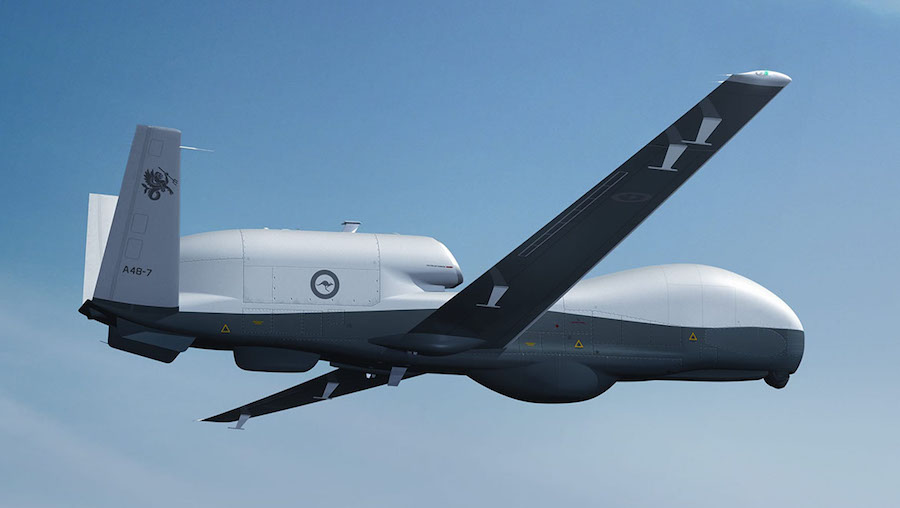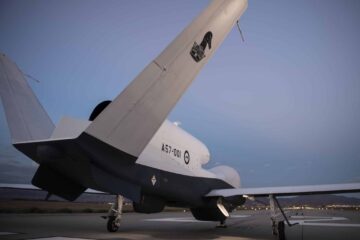Northrop Grumman press release
The event, attended by Australian, U.S. government, and defense officials, highlights the continued progress of the MQ-4C Triton program for both the Royal Australian Air Force and the U.S. Navy.
“Today marks a significant milestone for Australia and the MQ-4C Triton program. As we get ready for final system integration and flight test, we are one step closer to delivering this extraordinary maritime awareness capability to Australia.”
Tom Jones, Corporate VP and President of Northrop Grumman Aeronautics Systems
Australia is a cooperative program partner in the Triton program and was critical in helping shape the requirements for the system. As partners, U.S. and Australian defense forces will be able to share data collected by their respective Tritons, a critical ability in one of the world’s most strategically important regions.
“Triton will provide the Royal Australian Air Force with an unprecedented capability to monitor and protect our maritime approaches. Triton will work alongside the P-8A Poseidon and this unmanned aircraft system will allow us to cover significant areas, at longer ranges and has the ability to stay airborne longer than a traditional aircraft.”
Air Marshal Robert Chipman, Chief of the Royal Australian Air Force
Northrop Grumman initiated the build of the first Australian Triton in October 2020 at its production facility in Moss Point, Miss., and met another major production milestone in December 2021 when the fuselage and one-piece wing were mated in Palmdale, Calif. The aircraft is scheduled for production completion in 2023 and delivery to Australia in 2024.
Northrop Grumman’s family of autonomous HALE systems perform critical wide-area intelligence, surveillance, reconnaissance and targeting (ISR&T) missions. Today, autonomous HALE systems operate across the globe, with greater than 24-hour endurance, collecting essential ISR&T data over land and sea to enable rapid, informed decision-making. In the future, these systems will connect the joint force, implementing advanced autonomy and artificial intelligence and machine learning while delivering indispensable capabilities with fewer people to provide information at the speed of relevance.
– End –
About MQ-4C Triton Maritime Surveillance HALE UAV

According to its launch customer, the US Navy, the MQ-4C Triton is an autonomously operated system that provides a persistent maritime ISR capability using multiple maritime sensors.
The MQ-4C Triton air vehicle is based upon the United States Air Force (USAF) RQ-4B Global Hawk, while its sensors are based upon components of (or entire systems) already fielded in the DoD inventory.
Along with the P-8A manned aircraft, the MQ-4C Triton is integral to the U.S. Navy’s Maritime Patrol and Reconnaissance Force (MPRF) Family of Systems. The MPRF is the operational agent for the MQ-4C Triton and Commander, Patrol and Reconnaissance Group (CPRG) is the fleet sponsor for the manned/unmanned integration concept.
Australia’s 2016 Defence White Paper identified the requirement for seven high altitude, long endurance Triton unmanned aircraft. Northrop Grumman will deliver the Triton through a cooperative program with the United States Navy who has itself expressed a need for 70 aircraft. The German Defence Ministry confirmed in March 2017 that it had decided to buy the MQ-4C to replace the EuroHawk program, with deliveries occurring after 2025. The plan has now been canceled.
MQ-4C Triton specifications:
- Length: 47 ft 7 in (14.5 m)
- Wingspan: 130 ft 11 in (39.9 m)
- Height: 15 ft 5 in (4.6 m)
- Empty weight: 14,945 lb (6,781 kg)
- Gross weight: 32,250 lb (14,630 kg)
- Maximum speed: 357 mph (575 km/h, 320 kn)
- Range: 9,400 mi (15,200 km, 8,200 nmi)
- Endurance: 30 hours
- Service ceiling: 56,000 ft (17,000 m)






